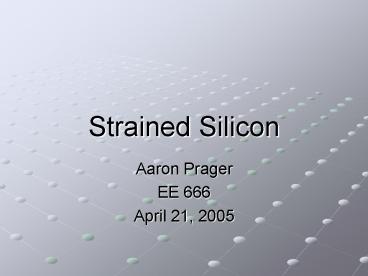Strained Silicon
Title:
Strained Silicon
Description:
Electrical symmetry destroyed by strain. Four energy valleys go down in energy, two go up (in biaxal strain) Vice versa in unaxial ... –
Number of Views:949
Avg rating:3.0/5.0
Title: Strained Silicon
1
Strained Silicon
- Aaron Prager
- EE 666
- April 21, 2005
2
Outline
- Introduction
- CMOS
- Strained Silicon
- Why is it good?
- How does it work?
- How do we make it?
- Conclusions
3
CMOS
- Complimentary Metal-Oxide-Semiconductor
- Basis for most computer chips
- Were good at making CMOS!
4
Moores Law
- More and more transistors every year
- Higher and higher speeds
- CMOS cant get much smaller
- How can we continue innovating and moving faster?
5
Strained Silicon
- As gate length shrinks, mobility decreases
- Increased doping to combat short channel effects
- Method to increase mobility of electrons and
holes in the channel of an FET - Tensile and compressive strain applied to channel
6
Strained silicon
- How does it work?
- Basic idea Change the lattice constant of
material - Changes energy band structure!
7
Strained Silicon
- So, what is actually happening?
8
Strained Silicon Electrons
- So, what is actually happening?
- Electrical symmetry destroyed by strain
- Four energy valleys go down in energy, two go up
(in biaxal strain) - Vice versa in unaxial
- INTERVALLY SCATTERING REDUCED!
- Change in curvature
- Reduction in effective mass!
9
Strained Silicon Holes
- How about the holes?
- Unaxial strain reduces effective mass
- Biaxial Strain splits LH and HH bands, reduces
scattering
10
Fabrication
- Effect was noticed in early 1950s
- Generally an effect to be avoided
- Why bother?
- In recent years scaling has become more difficult
- Idea revived at MIT in early 1990s
11
Fabrication
- Two types of strain
- Compressive
- Tensile
- Two directions of strain
- Unaxial
- Biaxial
12
Biaxial Fabrication
- Biaxial techniques pioneered first
- Method preferred by IBM though examined by all
major semiconductor firms - Graded SixGe1-x layer grown on silicon substrate
- Si Lattice constant 5.4309Å
- Ge Lattice constant 5.6575Å
- X.9
13
Biaxial Fabrication
- Additional SixGe1-x grown on top of graded layer
- Wafer is polished
- Thin layer of silicon epitaxially grown on layer
of SiGe - SiGe has larger lattice constant than Si (1
larger) - Strains the x and y directions
- Layer must be thin to avoid relaxation
- Pseudomorphic
14
Biaxial Fabrication
- Increases electron mobility
- No great change in hole mobility
- Has problems
- Diffusion of Ge into Si
- Dislocations
- Cost (?)
15
Biaxial Fabrication IBM Gets Clever
- First cleverness SiGe on insulator, with
silicon epitaxially grown on SiGe - Positive benefits of SOI (lower capacitances,
faster switching, lower leakage) as well as
benefits of strain - But wouldnt it be good if we could do strained
silicon on insulator without SiGe underlayer?
16
Biaxial Fabrication IBM Gets Clever
17
Biaxial Strain
- IBM proposing strained Germanium channel
- Excellent electrical properties
- Hard to grow insulator
- Epitaxial growth makes it possible
18
Unaxial Strain Intels Baby
- Problems with Biaxial strain
- Reexamine the problem
- Need strain in the channel of the MOSFET
- Tensile strain in NMOS, Compressive in PMOS
- Strain needed in direction from source to drain
19
Unaxial Strain Intels Baby
- NMOS
- Standard fabrication
- Cap with SiNx
- High temperature deposition, thermal expansion
pulls channel - Unaxial Strain Only one direction
- 10 increase in Idsat
20
Unaxial Strain Intels Baby
- PMOS
- Remove source and drain
- Selectively grow epi-SiGe in source and drain
- Nickel Silicide grown on source, drain, gate
- Improvements in Idsat of 25-30
21
Unaxial Strain Intels Baby
- PMOS
- In Intel fabrication method FET also covered by
the SiNx layer - No major loss!
- In general, strain showing compatibility with
future technology
22
Quantum Effects
- Strain always a problem
- Unwanted strain changes wave functions
- Work always done to remove strain
- Proposals to actually increase strain instead
- Remove all energy valleys except one, meaning no
other changes could occur
23
Conclusions
- Strain in Silicon can increase mobility in NMOS
and PMOS FETs - Biaxial and Unaxial strain techniques developed
- In use by major players































